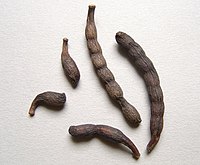| Xylopia quintasii | |
|---|---|

| |
| Conservation status | |
 Least Concern (IUCN 3.1) | |
| Scientific classification | |
| Kingdom: | Plantae |
| Clade: | Tracheophytes |
| Clade: | Angiosperms |
| Clade: | Magnoliids |
| Order: | Magnoliales |
| Family: | Annonaceae |
| Genus: | Xylopia |
| Species: | X. quintasii |
| Binomial name | |
| Xylopia quintasii Pierre ex Engl. & Diels | |

| |
| Range map of Xylopia quintasii | |
| Synonyms | |
| |
Xylopia quintasii, commonly known as Elo, is a species of evergreen tree, in the family Annonaceae that grows 20-25 metres tall. Xylopia quintasii can tolerate temperatures above at least 1°C. Its leaves are oblanceolate and petiolate. Xylopia quintasii produces six star-shaped flowers. Xylopia quintasii is native to West Africa. It is known as Aghako in Ghana and Mvomba in Cameroon.
Distribution
Xylopia quintasii is found in most of North-Western Africa. Xylopia quintasii is commonly found in evergreen and deciduous forests and coastal thickets. This species is present in the following countries:
Uses

Xylopia quintasii is not commonly sold on the international market and is usually only used for local purposes. It is sometimes used in Grains of Selim and is smoked. The wood of Xylopia quintasii is used for house building in posts, poles, and planks. It can also have other uses like bowls, plates, weapons, tools, toys, etc. Many parts of Xylopia quintasii are used in traditional medicine. The bark is used to treat illnesses like bronchitis and pneumonia. The inner bark is used to treat swellings. A lotion can be prepared from the bark to treat headaches.
References
- Botanic Gardens Conservation International (2018). "Xylopia quintasii". IUCN Red List of Threatened Species. 2018: e.T136112065A136112067. doi:10.2305/IUCN.UK.2018-2.RLTS.T136112065A136112067.en. Retrieved 28 February 2023.
- ^ "Elo (Xylopia quintasii)". Retrieved 16 February 2024.
- "Xylopia quintasii". Hortipedia. Retrieved 28 February 2023.
- ^ "Xylopia quintasii (PROTA)". MediaWiki. Retrieved 28 February 2023.
| Taxon identifiers | |
|---|---|
| Xylopia quintasii | |